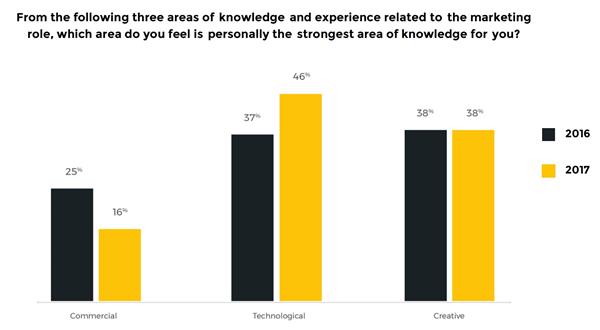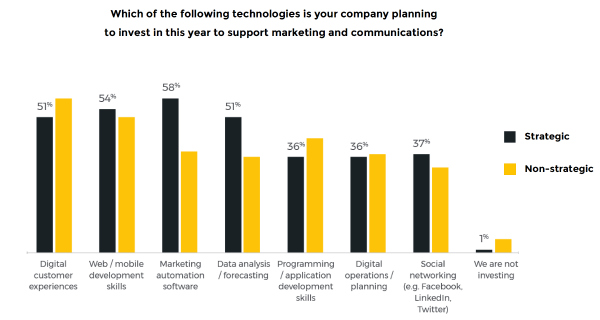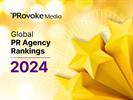Arun Sudhaman 12 Jun 2017 // 6:48AM GMT

Technology promises much. And, already, we are seeing how digital platforms are redefining traditional notions of communications, ushering in an era of more personalised, measurable content. Yet all of that promise counts for naught if organizations — and the people charged with managing their brands — are unable to get to grips with the rapid changes wrought by technological disruption, and harness new techniques and tools for the benefit of their companies.
To investigate these issues in greater detail, the Holmes Report partnered with Octopus Group to convene a roundtable of senior communicators in London, all of them drawn from some of the technology sector’s biggest players.

Panellists
Abhinav Kumar — chief marketing and communications officer, Tata Consultancy Services
Darshna Kamani — EMEA communications director, Barracuda
Paul de Lara — corporate communications director EMEA, Oracle
Rainer Bock — head of corporate PR and strategic projects, corporate communications, global, Kaspersky Lab
Simon Skinner — head of communications UK & Ireland, Dell
Sandy Purewal — executive chairman, Octopus Group
Moderator: Arun Sudhaman — editor-in-chief, Holmes Report
The discussion began by considering some research from Octopus unit Loudhouse, which shone a spotlight on the various ways that technology is changing the equation for in-house marketing and communications leaders. For example, 61% routinely work beyond their contracted hours, while 59% say they are having to become more creative and innovative.
57% think they need to make more effective use of the various technologies they have at their disposal, while 53% say they spend too long on decision-making — both relatively high proportions. "You’ve got two communities in the 30% range, haven’t you?" said de Lara. "You’ve got the people who think they’re experts and the people who just don’t think it’s relevant."
As Purewal noted, though, the challenge continues to revolve around the pace at which new technological platforms appear. "I think there are people who would say, you know what, I’ve got a strategy which is press and social which is Twitter, LinkedIn, Facebook, maybe Instagram and I’m done," he pointed out. "But really every time I look around there’s something new that’s coming out."

When it comes to their strengths, in-house leaders reported a considerable decline in commercial knowledge related to the marketing role, while the strongest is technological. While this might seem a worrying trend, Skinner believes it again reflects the pace of technological change.
"A lot of senior execs say ‘I need to go on Twitter, I need to get on LinkedIn, how do I do it?’ and they look to you as if you should be this person who should know all about it, and we absolutely should be but if you are getting that, that forces me, encourages me to become an expert on these things because a lot of people have come to me saying I need your advice," he said. "By focusing on that I’ve got to take my eye off something and I could see how possible, for some people, they could choose to go with the commercial business. I think that’s a mistake. I think PR people that don’t understand their market, their business — they are less valuable as a communications consultant."

Meanwhile, when asked where they plan to invest, numerous technologies emerge, led by digital customer experiences and marketing automation technology. And while some of this speaks to the integration of communications across the broader marketing and technological function, not everyone was persuaded that these plans really matter.
"I would basically say I don’t really know and I don’t really care," asserted Bock. "Because I create a campaign and then I talk to the colleagues who are there who own these tools to make it happen. If we don’t have it in house I’ll find an agency who can help us push the message out through tools they have. The infrastructure is held somewhere else and if something isn’t available within our organisation we will find a way to get to it. "
Data vs creativity
"Sure you’ll get the eyeballs but what does it do for your brand or your business?"
The rise of marketing automative software now offers tangible methods to connect content to commerce. Yet, for the people charged with creating that content, the risk is that the deluge of data overrides the essential creativity of the brand communication process.
"If you don’t have a good story to tell now you will just be washed away by the flush of new studies out there," said Bock, pointing out that the plethora of tools enables companies to spend "a horrible amount of money" to create reach. "You can just go to an agency and say I want two million views for this video and they will make that happen if you give them enough money."
That ease of reach, added Bock, means that "to be really noticed you have to be more creative than ever."
Kamani was more circumspect, pointing out that data brings some "method to the madness", particularly when it comes to demsontrating the "business value of creative ideas."
"If it’s not resonating with business leaders at least you’ve got data to back it up," she noted. "I think there’s a balance to that."
Of course, the data itself often requires scrutiny, particularly when it revolves around reporting outreach. As Skinner pointed out, "our executives just don’t care about" these types of metrics, assigning far more importance to "what’s been heard" rather than "what we’ve said."
"You have to be very disciplined to make sure that the data is actually telling you something that is relevant to the business not just to you as a PR person," explained Skinner. "And that’s new for us because in the old world when we were growing up doing PR it was like coverage, hurrah! It doesn’t wash anymore."
Skinner also noted that data should be put to work in terms of delivering genuine insights, rather than spurious coverage reports. "Information about audience behaviours, audience interest areas, about what competitors are doing, white space analysis, all that kind of stuff. Again that’s all new stuff that the consumer PR industry pioneers, much stronger than the B2B environment, and there’s much to be learned."
Does data drive better ideas? Our panellists had mixed opinions, looking to the entertainment world to back up their arguments. Kumar pointed to a Bollywood film that a management school developed using audience research, but which performed poorly because, in Kumar’s words, "if you have a fully data driven idea only it tends to be a Frankenstein."
On the flipside, as de Lara noted, "Netflix created House of Cards because they did the data and the data said this is good." The value of algorithms to identify what people want cannot be discounted, added Purewal, even if the clash of creativity and data can create a "crisis of confidence."
"So you end up not confident about your idea that you are pitching to your client," said Purewal. His antidote? Testing. "So we ran three campaigns for one client and said that one’s performing better than the other two, put the money behind that one. And I think that’s the reality regardless of what agencies will say, and what we’re talking about creativity is actually risk."
That approach brought considerable support from the assembled communications leaders. However, if ideas are being backed based on social media performance, for example, will that not just funnel companies towards whatever the viral meme du jour is? Facebook tells brands which posts are performing well, but that might not chime with an organization’s priorities in terms of brand-building.
"Sure you’ll get the eyeballs but what does it do for your brand or your business?" asked Kumar.
The risk, noted de Lara, is that data is being used so that "you can get precisely the insight to justify your existence. That’s the problem. No one says hmm, here’s the data that says I didn’t do very well, who’s sending that round?"
Content vs commerce
"If we start walking around our organisation saying we’re going to drive you lots of leads then I think we’re writing the end of PR"
In a B2B context, Purewal believes that marketers must be focused on whether their content is helping them drive commercial results. "If it’s about selling more stuff then everything that you do, everything that PR does, that marketing does ,is to make that boat go faster and that’s the ultimate measure," he explained. "So if you look at pipeline contribution for marketers ,that’s more important than marketing qualified leads and if you work all the way back that’s more important than awareness because you can buy awareness. What you can’t buy is sales and that’s what we’re trying to do."
However, our panel of in-house leaders remain unsure that their work can be measured along these lines. Kamani, for example, is more focused on making sure her senior executives are on top-tier media, because it drives awareness. "It’s much more valuable than you putting out some stats to say this is what your content achieved."
"My executive knows that that CNBC is his or her audience," said Skinner. "They don’t know what Facebook is, they don’t know what Twitter is. I don’t know many PR people who put their neck out and say I will contribute to pipeline. You’re right — it gives me a load of great stats to prove that I’m doing a great job…but also I know I’ve got to sit in front of the president, the head of sales, my boss and say right, this is it, and they can cut through it."
De Lara also supported the view that "gut feeling" remains a vital indicator. "Yes there’s going to be charts and numbers and all that kind of stuff but that emotive impact of what we do, that gut feel kind of thing, can we measure that?" he asked. "Sales guy measures it on numbers, end of story. But there is a softness to what we do."
Yet that "softness" — that focus on building relationships rather than just revenue — may be of less value in an era where the weight of column inches can be measured against business results. Bock, for one, thinks this poses a fundamental threat to the value of the public relations function.
"Even if you have someone on the front page of Time magazine, my management would still ask show me what leads did it bring," said Bock. "I agree with you that we have this gut feeling and I also agree that these are extremely valuable pieces but my fear these days is that the people around us are getting so data focused that at a certain point they would even then not start valuing [media coverage] any more. It’s getting tricky."
It certainly is, to the extent that Kumar wondered if this kind of thinking could end up "killing the PR function" by turning it into a sales enablement function.
"Why do we need a PR department?" he asked rhetorically. "We already have a sales enablement function which generates great leads. They do the same, they do it better."
Perhaps the trick, as de Lara explained, is to ensure that PR people are clear about what they can realistically accomplish.
"It is very important for us to be very clear where we sit within the sales cycle," said de Lara. "The mistakes may be coming when PR people are saying look here’s that coverage, I’m generating you lots of sales leads. I’m not sure that’s really true. There are other things that the company does that generates the actual sales leads but we sit at the awareness raising, the reputation building end of the funnel and it’s not necessarily true that what we do drives sales leads this quarter."
"We are higher level and it’s important for us to be clear about what we can and can’t achieve because if we start walking around our organisation saying we’re going to drive you lots of leads then I think we’re writing the end of PR."
Purewal, unsurprisingly, resisted the notion that public relations cannot prove its commercial viability. "Having looked at our data for our clients I’m now convinced PR component is one of the single most important factors to drive leads, you just can’t measure it over a quarter — you measure it over several quarters."
"That’s because what we’re doing is putting stuff at the top of the funnel," responded de Lara.
"It’s not just the top of the funnel," said Purewal. "The quality of the idea, the quality of the creative in the B2B context."
Yet, if P&G and Coca-Cola can measure how their content drives sales, why can’t B2B brands? "I think it’s getting there with B2B," said Kamani. "We are the people who are creating content and generating the first level of awareness in terms of what’s coming up from the PR departments and then how that is used so therefore it’s maybe the start of a lead versus actually generating the lead."
Hype vs reality
"If you start paying for the technology out of the PR budget it very quickly starts going downhill"
Today’s communications leaders are not only bombarded by a nonstop media landscape, but a steady drumbeat of technological tools that promise to make sense of this cacophony of noise and information. How do they sort hype from reality when it comes to making technology work for them, and resist the temptation to try every shiny new toy?
"In most cases you’ve got to try things out before you know if they are going to be valuable to you or not, especially if it’s something completely new," responded Kumar. But at the same time, I am really pushing back on the culture in always going for the shiny new toy."
The panellists agreed that a lack of credible, third-party reviews of new products and tools has made them particularly wary, making them more reliant on word-of-mouth from their peers. Surely agencies have a role to play here?
"I’m biased but I think agencies are the answer because that’s a part of what their contribution to you is," agreed Purewal, who noted that his team has whittled down thousands of tools to a list of 72 (and a smaller list of six) that they recommend to clients. "The challenge is most of our clients have got a CRM system, have got some form of marketing automation platform — but the reality is people are not using the functionality of today, they are using the functionality of five years ago. So you are better off having some technologies and using them better rather than going for the new shiny objects because there’s about 6,000 of them."
For the clients, though, budget remains a limiting factor. "If you come to me with an idea to spend some money on some tech the likely place I’m going to find that budget from is your retainer," said Skinner.
Purewal pointed out that half of the recommended tools are free, while many of the others will already be deployed by a client. "If you start paying for the technology out of the PR budget it very quickly starts going downhill and you can’t do it," he noted.
Ultimately, Bock advised overall caution with tools. "We don’t have enough people to use the actual power of most tools," he said. "I am trying to get rid of a few monitoring tools for example because we are using one function in that and one function in that and one function in that. Unfortunately there is not one tool that combines all these functions so we have to think about which of them do we really need and which of them do we not need and is that function worth investing $1000 a month or not."
PR vs marketing
"But it’s a bit scary because if you’re a bit crap you’re likely to be exposed and that’s a worry for some"
Bock admitted that the "fluffy ideas" can no longer fly, because of how easy they are to expose. And while de Lara thinks commercial awareness is much more top of mind for today’s in-house communicators, Skinner worries that they are too closely interlinked to the marketing function, rather than the overall business.
"Sales people are scary, they’re tough people, and we are not," said Skinner. "It’s easier to be aligned to marketing and aligned to comms than it is to align to salesmen a lot of the time. Again, I should say I’ve got lovely people I work with."
That sales vs marketing equation continues to impact the role of PR within a B2B context, added Kamani. Kumar, though, thinks some of this friction is no bad thing, particularly as a PR function should be have a much broader remit.
"If you have complete alignment it could mean subservience, if you are just following the sales agenda," said Kumar, noting that the continued inability to measure brand metrics underpins this tension. "There still isn’t today a standard to really measure a brand — still not recognised as a balance sheet asset."
At TCS, Kumar has addressed this by working with Brand Finance to value the company’s brand. "But you know it’s patchy, there are no standards on it, it’s not widely adopted and that’s one of the reasons why sales people appear scary — on their metrics you have certain success but the work that marketing and comms does cannot be showcased in a way which is meaningful to them."
Meanwhile, Skinner wondered whether the increased rigour brought to assessment and evaluation would expose the PR function even further. "It’s making us better communications people and it’s making us more relevant," he pointed out. "But it’s a bit scary because if you’re a bit crap you’re likely to be exposed and that’s a worry for some."
Moves made by digital publishers, in terms of retargeting content to users based on their digital footprint, add another layer of complexity to the traditional role of the PR leader.
"We spent 20 years telling clients that the media they want to talk to, the journalists they want to talk to, the influencers you want to talk to, to get your message out are these people," said Skinner. "Now what’s springing up is this bunch of other assets not in the recognised media and you’re thinking, what’s your value to a client?"
That approach may not lead to better quality content, but it might help drive vanity metrics such as impressions and likes. Are brands brave enough to take the high road when all of their rivals are focused on such measures of success?
"It could also cost you your job," said de Lara. "I think the point there is that earned media is different from paid media and that paid media model absolutely needs to be part of our armoury. We need to be engaged with it, be involved in it. A lot of that paid media will derive its content from our corner of the company, fine, but that doesn’t mean to say that our earned media model is any less valuable."
With that in mind, de Lara advised panellists to focus on what makes public relations so distinctive to begin with, rather than becoming a subset of marketing. "Viral is earned," he said. "That’s the ultimate pinnacle. It looks different now than it did before but that’s the creative idea, that’s the spark of inspiration that keeps your job because if we just sit in the paint box that’s fine but you’ll just become a marketing administrator. "
"I think we all want to stand out in a certain way," agreed Bock. "So if the basic everyday work is data-driven, based on what is proven to work that’s fine but in between you have to get your audiences out of the everyday routine and do something that makes them think, they’re good."
The opportunity for public relations, added Purewal, is to prove it is worth more in terms of the budget it attracts, rather than getting pushed to the executional fringes.
"PR is great at driving traffic to your site, it’s great in creating trust because it uses an indirect route to do that, it’s great at coming up with ideas that are more sophisticated than an ad agency would, for example, because they look at it in one dimension. So all the things are there — it’s just it needs to plug into a machine which is outside of the PR department."
"If you are being blunt about it, when you want double the amount of budget than you’ve got at the moment why is it that you’ve got this budget and marketing’s got this budget and technology has got this budget?" asked Purewal.
But more than one panellist worried about becoming "unpopular" by competing with marketing for budget. Perhaps the answer is to integrate the functions, as Kumar has done at TCS.
"I think it removed the frictions which were there and between the two sides there were certain complimentary skills that could then be cross leveraged," said Kumar. "On the PR side we had great story tellers but often were not close enough to the business objectives. While on the marketing side it had great capability to launch and run campaigns, do things in a big way, events and so on and so forth.
"It needs either the integration or a leadership team which understand that this collaboration is essential and forces it under whatever structure that the company has,"added Kumar, noting that the company’s government affairs function also contributes to campaigns now. "So I would say it’s only been a very, very positive experience for us and I think somewhere or other that needs to be created. Otherwise often there are these silos and the fight for resources."



































.jpg)






























